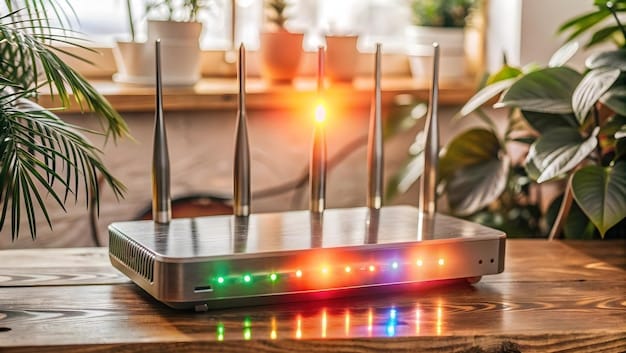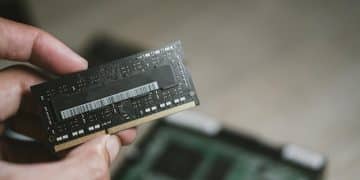Will Wi-Fi 7 Router Upgrade Boost Home Network Speed by 40%?

Upgrading to a Wi-Fi 7 router may not guarantee a flat 40% speed increase, as real-world improvements depend on factors like existing hardware, network congestion, and device compatibility, making it essential to assess your specific needs.
Wondering if upgrading to a Wi-Fi 7 router really improve your home network speed by 40%? It’s a question on many tech enthusiasts’ minds, and the answer isn’t always a straightforward yes.
Understanding Wi-Fi 7 and Its Potential
Wi-Fi 7 represents the latest generation of wireless technology, promising faster speeds, lower latency, and greater network capacity compared to its predecessors. But what exactly makes it different, and how does it achieve these improvements?
Key Features of Wi-Fi 7
Wi-Fi 7 introduces several advancements that contribute to its enhanced performance. These include:
- 320 MHz Channel Bandwidth: Wider channels allow for more data to be transmitted simultaneously, increasing throughput.
- 4K QAM (Quadrature Amplitude Modulation): This technology increases the amount of data that can be encoded in a single signal, enhancing data transfer rates.
- Multi-Link Operation (MLO): MLO enables devices to connect to multiple frequency bands (2.4 GHz, 5 GHz, and 6 GHz) simultaneously, improving reliability and reducing latency.
These features combined result in a theoretical maximum speed of up to 46 Gbps, significantly higher than Wi-Fi 6 and Wi-Fi 6E.

In conclusion, Wi-Fi 7 technology offers substantial potential for improving network performance through wider channels, more efficient data encoding, and multi-link operation.
Factors Affecting Real-World Speed
While Wi-Fi 7 has impressive theoretical capabilities, the actual speed increase you experience at home can vary widely. Several factors come into play, influencing whether you’ll see that promised 40% boost.
Client Device Compatibility
Your devices need to support Wi-Fi 7 to take full advantage of its benefits. If your smartphones, laptops, and other gadgets only support older Wi-Fi standards (like Wi-Fi 6 or Wi-Fi 6E), they won’t be able to utilize Wi-Fi 7’s advanced features.
Even if you have a mix of Wi-Fi 7 and older devices, the older devices can create bottlenecks in your network, limiting the overall speed improvement.
Network Congestion
The number of devices connected to your network and the activities they are performing can significantly impact your Wi-Fi speeds. A crowded network can lead to congestion, reducing the bandwidth available for each device.
- Number of Connected Devices: The more devices using the network simultaneously, the more the available bandwidth is divided.
- Bandwidth-Intensive Activities: Streaming high-definition video, online gaming, and large file downloads consume a lot of bandwidth, leading to slower speeds for other devices.
In conclusion, real-world Wi-Fi speeds are affected by client device compatibility and network congestion, so Wi-Fi 7 may not always provide the expected speed boost.
Assessing Your Current Network
Before investing in a Wi-Fi 7 router, it’s essential to assess the performance of your current network. Understanding its strengths and weaknesses can help determine if upgrading is the right move for you.
Conducting a Speed Test
Start by performing a speed test using online tools like Speedtest by Ookla or Fast.com. Run the test at different times of the day to get an average reading of your network speed. Take note of both upload and download speeds.
Compare your results with the speeds you are paying for from your internet service provider (ISP). If there is a significant discrepancy, it could indicate issues with your current router or ISP connection.
Evaluating Your Router’s Performance
Check the specifications of your current router. Is it an older model that supports older Wi-Fi standards? If so, it may be a bottleneck in your network. Also, consider its age. Routers degrade over time, affecting their performance.

In conclusion, Assessing your current network by conducting speed tests and checking router performance can determine the efficiency of an upgrade to Wi-Fi 7.
The Cost-Benefit Analysis of Wi-Fi 7
Upgrading to Wi-Fi 7 can be a significant investment, considering the higher price point of these routers and the need for compatible devices. It’s crucial to perform a cost-benefit analysis to determine if the upgrade is justified for your specific needs.
Initial Investment
Wi-Fi 7 routers are typically more expensive than Wi-Fi 6 or Wi-Fi 6E models. The higher cost reflects the advanced technology and features they offer. Consider your budget and how much you are willing to spend on upgrading your network.
Long-Term Savings
While the initial cost may be high, there could be long-term savings. A faster and more efficient network can improve productivity, reduce downtime, and enhance the overall user experience. If you rely heavily on your internet connection for work or entertainment, the investment may pay off.
In conclusion, the cost-benefit analysis of Wi-Fi 7 involves weighing the initial investment against long-term savings and productivity gains.
Setting Realistic Expectations
It’s important to approach a Wi-Fi 7 upgrade with realistic expectations. While the technology offers significant potential, the actual speed increase you experience may not always match the theoretical maximum.
Understanding Theoretical vs. Real-World Speeds
Manufacturers often advertise the theoretical maximum speed of their routers. However, these speeds are achieved under ideal conditions in a laboratory setting. Real-world conditions are rarely perfect and can significantly impact performance.
Factors such as interference from other devices, building materials, and distance from the router can affect your Wi-Fi speeds. Be prepared to see speeds lower than the advertised maximum.
Factors Limiting Speed Improvement
Even with Wi-Fi 7, several factors can limit the speed improvement you experience. These include:
- ISP Limitations: Your internet plan may have a maximum speed cap. Even if your Wi-Fi network is capable of faster speeds, you won’t exceed the limits set by your ISP.
- Device Capabilities: As mentioned earlier, your devices need to support Wi-Fi 7 to take full advantage of its benefits. Older devices can create bottlenecks.
- Network Interference: Interference from other devices, such as Bluetooth devices and microwaves, can disrupt Wi-Fi signals and reduce speeds.
In conclusion, approach a Wi-Fi 7 upgrade with realistic expectations by understanding the difference between theoretical and real-world speeds and considering potential limitations.
Alternatives to Upgrading to Wi-Fi 7
If the cost or other factors make a Wi-Fi 7 upgrade unappealing, there are alternative ways to improve your home network speed without breaking the bank.
Mesh Wi-Fi Systems
Mesh Wi-Fi systems can improve coverage and eliminate dead zones in your home. These systems use multiple nodes to create a seamless network, ensuring a strong signal in every corner of your house. Mesh systems can be a cost-effective way to improve network performance without upgrading to the latest Wi-Fi standard.
Optimizing Router Placement
The location of your router can significantly impact its performance. Placing it in a central, open location can improve coverage and reduce interference. Avoid placing your router near walls, metal objects, or other devices that can disrupt the signal.
Alternatively, consider upgrading your Ethernet cables to Cat6 or Cat6a cables. These cables support faster speeds and can improve the performance of wired connections.
In conclusion, Mesh Wi-Fi systems and optimizing router placement are feasible alternatives to Wi-Fi 7 upgrade, which can save your money.
| Key Point | Brief Description |
|---|---|
| 🚀 Wi-Fi 7 Potential | Offers faster speeds and lower latency with features like 320 MHz channels. |
| 📱 Device Compatibility | Requires devices that support Wi-Fi 7 to utilize its advanced features. |
| 💡 Network Congestion | The number of connected devices and bandwidth-intensive activities can reduce speeds. |
| 💰 Cost-Benefit | Weigh the initial investment against long-term savings and productivity gains. |
FAQ
▼
Wi-Fi 7 is the latest generation of wireless technology, offering faster speeds, lower latency, and increased network capacity compared to previous standards like Wi-Fi 6 and Wi-Fi 6E. It uses technologies like 320 MHz channels and 4K QAM.
▼
Not necessarily. The actual speed increase depends on factors like device compatibility, network congestion, and the limitations of your internet service provider (ISP). Real-world speeds often differ from theoretical maximums.
▼
Yes, to fully utilize Wi-Fi 7, your devices must also support the standard. Older devices can create bottlenecks in the network, limiting the overall speed improvement. Consider upgrading your devices for optimal performance.
▼
Alternatives include using a mesh Wi-Fi system, optimizing your router placement, and upgrading your Ethernet cables. These options can improve network performance without investing in the latest Wi-Fi standard.
▼
Conduct speed tests at different times of the day to get an average reading of your network speed. Also, evaluate the performance of your current router and compare it with the speeds you’re paying for from your ISP.
Conclusion
In conclusion, while upgrading to a Wi-Fi 7 router offers promising advancements, the actual speed improvement can vary. Consider the factors discussed, assess your specific needs, and weigh the costs and benefits before making a decision to ensure it’s the right choice for your home network.





